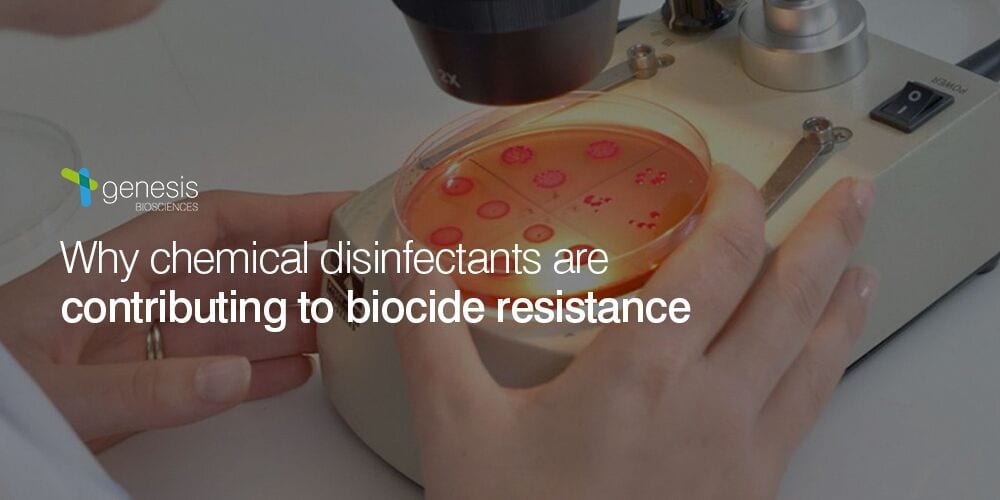
Overused and under-performing: why chemical disinfectants are contributing to biocide resistance
On February 27 2017, the World Health Organization issued a stark warning that superbugs— drug-resistant bacteria and pathogens—pose one of the most dangerous and imminent threats to human health across the world as biocide resistance.
The announcement follows an earlier proclamation from the same organisation, who in 2014 published their first report on antimicrobial resistance (for ‘biocide resistance’), claiming “this serious threat is no longer a prediction for the future, it is happening right now in every region of the world.” [1]
The European Food Safety Authority and European Centre for Disease Prevention and Control has estimated that superbugs kill 25,000 Europeans each year and while most of these deaths occur among older patients in hospitals or nursing homes, or patients whose immune systems are suppressed, some are among the young and healthy. A new study of paediatric hospitals found that drug-resistant infections in children have increased sevenfold in eight years. [2]
With growing evidence that shows a clear link between antimicrobial resistance and the negligent use of biocidal chemical cleaners [3], the use of these products within the facilities management shows no signs of slowing down.
And, with increasing concerns about the rise of ‘superbugs’ from the public, now more than ever contractors within the facilities management industry needs to recognise the risk of biocide resistance and change their reliance on chemical biocidal cleaners.


Reasons for biocide resistance
“The serious threat of biocidal resistance is no longer a prediction for the future – it is happening right now in every region of the world.”
Chemical disinfectants have been used for decades to control bacteria, but human error in the application of biocidal products can result in the development of immune organisms.
One of the key reasons for this problem is over dilution of chemical disinfectants by contractors. If too much water is applied to disinfectant concentrates, the amount of biocidal substance present can be reduced to a level that is no longer lethal to the targeted bacterial cell. This leaves a small proportion of the targeted bacteria remaining. These bacteria develop immunity and go on to pass it to their progeny. The result is the emergence of potentially harmful bacterial strains with reduced biocide susceptibility.
Another cause of biocidal resistance is the overuse of chemical disinfectants. Indiscriminate use of biocidal products can result in low level residues of biocides remaining on the surface after cleaning. The biocide residues come into long-term contact with the targeted bacteria and because the residues contain sub-lethal concentrations of the biocidal product, the targeted bacteria are becoming more resilient against the products used to treat them. This drastically weakens biocide efficacy and puts end-users at risk.


Why traditional chemical disinfectants pose a risk
Chemical disinfectants often contain antimicrobial additives that are effective against a broad spectrum of bacteria, fungi and viruses such as Triclosan (2,4,4′-trichloro-2′-hydroxy-diphenyl-ether, CAS #3380-34-5), Quaternary Ammonia Compounds (QACs) and metal ions (e.g. silver and copper).
Scientific studies have recently identified that pathogenic organisms are becoming increasingly immune to these additives.
In one study, 100 times the concentration of Triclosan was required to kill a resistant strain of E. colias compared to a strain not yet exposed to the antimicrobial. These resistant E. coli also showed resistance to a new antibiotic being tested at the time of the experiment. [4]
A 2012 study revealed that exposing E. coli bacteria to increasing concentrations of three different types of QACs resulted in E. coli populations that had become resistant to several families of antibiotics. The authors warn that use of low dosage use of QACs “may lead to the emergence of antibiotic-resistant bacteria and may represent a public health risk.” [5]
The consumer product giant Procter & Gamble warned in a 2004 article that, “The use of QACs in the home will expose a wide range of environmental and potentially pathogenic bacteria to these antimicrobials, often at sub lethal concentrations, making the home a potentially high-risk environment for resistance selection.” [6]
Antimicrobial resistance to silver-based additives has also recently been reported in strains of Salmonella typhimurium, E. coli, and other bacteria, after exposure to antimicrobial silver in wound dressings. [7]


What is being done to tackle the issue of biocidal resistance in the marketplace?
In 2015, the EU Biocidal Products Regulations (BPR) announced changes that only biocidal products containing ‘active substances’ supplied by an approved supplier on the list can be legally placed on the EU market. The regulations were put in place to ensure the safety of biocides on the European market and to improve the assessment of the substances and products permitted for marketing in biocides.
To be an approved supplier, the EU Biocidal Product Regulations (BPRs) requires detailed information on the risk of resistance development in organisms targeted by the biocidal product, which means there is greater scrutiny than ever for disinfectant claims.


The case for ‘good bacteria’ in preventing the rise of biocidal resistance
Just as there are harmful bacteria, there is also an abundance of beneficial bacteria that can be used to tackle the issue of biocidal resistance within the facilities management industry.
While traditional biocides have been predominantly used in the facilities management and cleaning industries, the benefits offered by new biological cleaning products cannot be ignored.
“Traditional cleaners are 20th century solutions to 21st century cleaning challenges.”
Dr Phil Caunt, Research and Development Specialist here at Genesis Biosciences said: “Traditional cleaners are 20th century solutions to 21st century cleaning challenges. These products can invariably leave low level biocide residues on surfaces, either due to human error or because of poor cleaning efficacy and so the continued use of chemical disinfectants will only serve to encourage the emergence of biocide resistant strains of bacteria.
“Most bacteria have a very positive effect on the environment and ourselves. In fact, the ecosystems in which we live rely heavily on beneficial microbiota, we even rely on bacteria on a very personal level within our digestive tract and on our skin to keep us healthy.
“This thought process is exactly the same for biological cleaners. Rather than using harsh chemicals, ‘beneficial bacteria’ can be applied to breakdown the soiling (dirt) on a surface.
“As beneficial bacterial replicate in the application area they degrade the organic soiling on the surface, competing with any harmful bacteria present for available growth nutrients. Through this mechanism the level of harmful bacterial populations can be reduced naturally by means of competitive exclusion.
“Furthermore, because the beneficial bacteria remain on, and in, the surface after application, they continue to work for as long as there is food for them, they can remove stubborn soiling over a few days or a few applications that even the strongest chemical products can never touch, and prevent the re-establishment of harmful organisms.”
To find out more about Genesis Biosciences, visit our About page.
If you liked this article, read a few more recent ones below:
- Probiotic cleaners VS chemical cleaners: which is best?
- Why the false economies of cleaning could be costing your business
- Why misleading disinfectant claims can harm you
- 9 things you didn’t know about feminine hygiene bins
If you’d like news from Genesis Biosciences delivered straight to your inbox, sign up to our regular newsletter.
[1] http://www.who.int/drugresistance/documents/surveillancereport/en/
[2] Incidence and Outcomes of Infections Caused by Multidrug-Resistant Enterobacteriaceae in Children, 2007–2015 https://doi.org/10.1093/jpids/piw093
[3] https://academic.oup.com/jac/article/49/1/11/658361/Biocide-abuse-and-antimicrobial-resistance-a-cause
[4] Yazdankhah, Siamak P., Anne A. Scheie, E. Arne Høiby, Bjørn-Tore Lunestad, Even Heir, Tor Øystein Fotland, Kristine Naterstad, and Hilde Kruse. ‘Triclosan and Antimicrobial Resistance in Bacteria: An Overview.’ Microbial Drug Resistance (Larchmont, N.Y.) 12, no. 2 (2006): 83–90. doi:10.1089/ mdr.2006.12.83.
[5] Soumet, C., E. Fourreau, P. Legrandois, and P. Maris. ‘Resistance to Phenicol Compounds Following Adaptation to Quaternary Ammonium Compounds in Escherichia Coli.’ Veterinary Microbiology 158, no. 1–2 (July 6, 2012): 147–52. doi:10.1016/j.vetmic.2012.01.030.
[6] McBain, Andrew J., Ruth G. Ledder, Louise E. Moore, Carl E. Catrenich, and Peter Gilbert. ‘Effects of Quaternary-Ammonium-Based Formulations on Bacterial Community Dynamics and Antimicrobial Susceptibility.’ Applied and Environmental Microbiology 70, no. 6 (June 1, 2004): 3449–56. doi:10.1128/ AEM.70.6.3449-3456.2004.
[7] Chopra, Ian. ‘The Increasing Use of Silver-Based Products as Antimicrobial Agents: A Useful Development or a Cause for Concern?’ Journal of Antimicrobial Chemotherapy 59, no. 4 (April 1, 2007): 587–90. doi:10.1093/jac/ dkm006.



Thank you for your great teams in Georgia and our special friends from England.we are trying to learn new ways to keep clean Robert Bruce Horne hornejanitoral.com thank you again